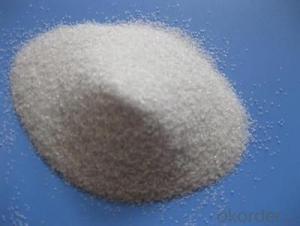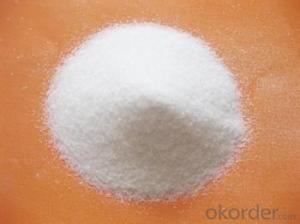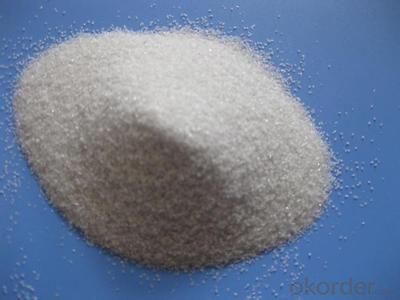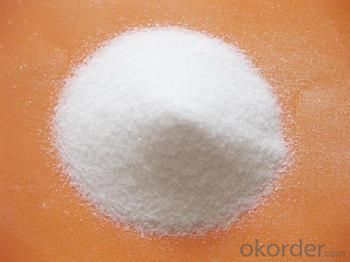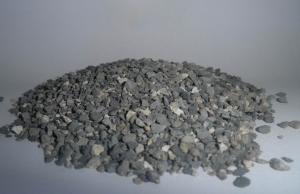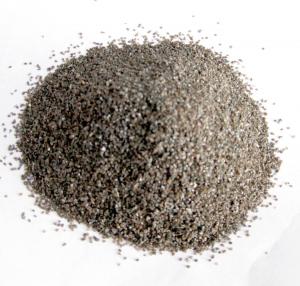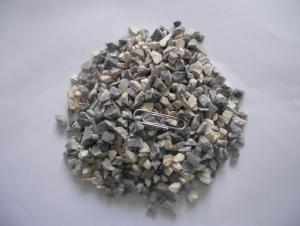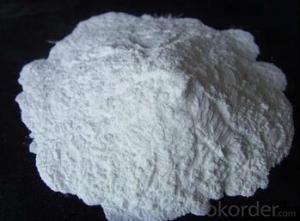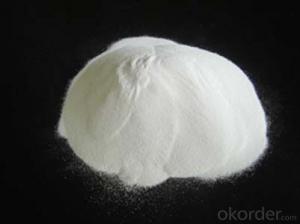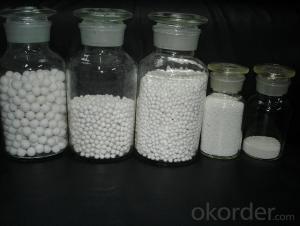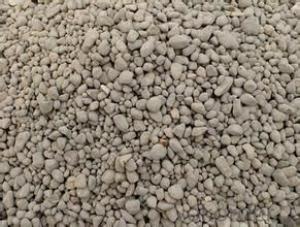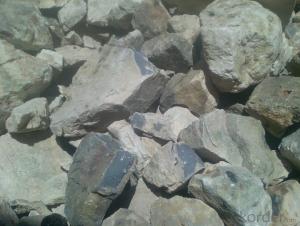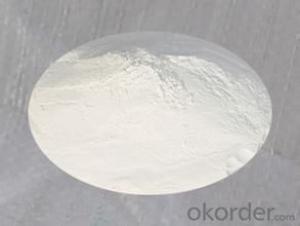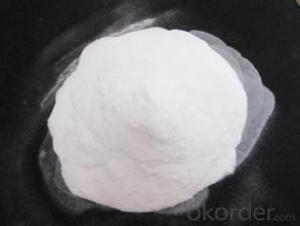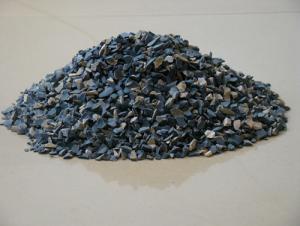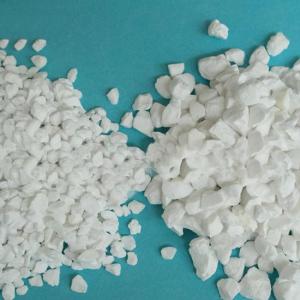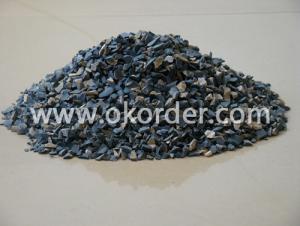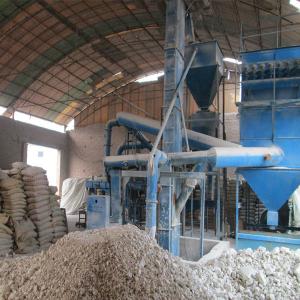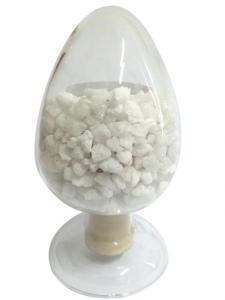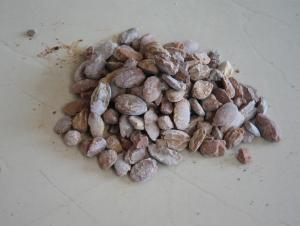Raw Materials for Refractory - Abrasive White Fused Alumina (WFA) for Sand Blasting 18 Mesh
- Loading Port:
- China Main Port
- Payment Terms:
- TT OR LC
- Min Order Qty:
- -
- Supply Capability:
- -
OKorder Service Pledge
OKorder Financial Service
You Might Also Like
Packaging & Delivery
| Packaging Detail: | 25kg/plastic bag, 1mt/jumbo bag or as you require |
| Delivery Detail: | within 7 days after sign the contract or your deposit |
Specifications
white fused alumina
Direct Manufacturer
lapping & polishing media
Ceramic grinding wheels
18 mesh abrasive white fused alumina (WFA) for sand blasting
White Fused Alumina/ WFA
White Fused Alumina, a kind of high-grade refractories, was made from the high quality alumina by melting above 2000 in the electric arc furnace and cooling. It is white with the main crystal phase alpha-Al2O3.The white alumina produced in titling electric arc furnace has the advantage of high bulk density and low porosity and the volume stability and thermal shock resistance can be improved.
Advantages
Flexible price policy
Equipped full line of test method.
Brilliant produce&supply&delivery ability
We passed the certification of ISO9001:2000
White fused alumina has Al2O3 content 99% min
All products will be supplied according to customers different requirement.
The laboratory is certified by government Inspection Bureau, that assures its quality stability.
Technical Data:
Application | specification | major chemical content % | |||||
AL2O3 | Na2O | SiO2 | K2O | Fe2O3 | |||
abrasive | F | 8#-60# | 99.5min | 0.26max | 0.08max |
| 0.06max |
60#-100# | 99.5min | 0.26max | 0.09max | 0.06max | |||
120#-150# | 99.5min | 0.26max | 0.10max | 0.06max | |||
180#-220# | 99.5min | 0.26max | 0.12max | 0.10max | |||
230#-800# | 99.3min | 0.32max | 0.15max | 0.10max | |||
1000#-3000# | 99.1min | 0.35max | 0.18max | 0.10max | |||
refractory | Section sand | 0-1mm | 99.5min | 0.29max | 0.30max | 0.02max | 0.06max |
1-3mm | |||||||
3-5mm | |||||||
5-8mm | |||||||
10-20mm | |||||||
0.3-1mm | |||||||
0-0.3mm | |||||||
1-2mm | |||||||
0.5-1.5mm | |||||||
Fine powder | 100#-0 | 99.0min | 0.40max | 0.30max | 0.03max | 0.20max | |
Moh's hardness | ≥9.0 |
true density(g/cm3) | ≥3.95 |
propotion | ≥3.6 |
porosity | ≤8.5 |
As refractoriness
White Fused Alumina is the main starting material to produce high-grade unshaped and shaped refractoriness and is widely used in the field of iron-steel industry,ceramics,petrochemical industry etc. It is the ideal material to produce the unshaped refractoriness such as large ladle castables,medium and high grade BF trough castables,gunning material,pre-cast shapes and is the main material to produce alumina products such as corundum bricks, corundum and mullite-corundum sagger,refined porous plug bricks, monolithic lance composite nozzle, lining material for high temperature industrial furnaces,etc.
As abrasives
White Fused Alumina can be used as consolidation & coating abrasives, wet or dry sprayed grit, suitable for ultra-precise grinding and polishing in the crystal and electronic industry and can be used to produce high-grade refractoriness. It is suitable to machine high stiffness &high tensile strength materials such as chilled steel, alloyed steel, high-speed steel, high carbon steel, etc. In addition, it can be used as catalyst, insulator, precise foundry sand, etc.
Size available:
Abrasive tool: F10-F220,F230-F1200;P12-P220;
Refractory : 0-1mm,1-3mm,3-5mm,5-10mm;100mesh,325mesh;
Other size is available as required;
Packing:
25kg/bag,40bags/big bag;
1000kg/big bag;
1000kg/big bag with pallet packing;
Other packing is allowed as required.
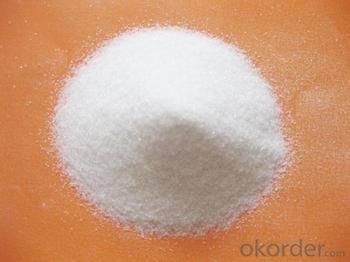
- Q: What are the use of fire-resistant material and admixture?
- Generally speaking, there are several admixtures: 1. Water reducing agent. It can ensure basic refractory castable flow value and significantly reduce its water mixing amount sodium hexametaphosphate and sodium tripolyphosphate 2. Plasticizer. It can increase plastic refractory mixture and enhance the ability of bentonite clay mud material stress strain 3. Gelling agent. It can make the colloidal solution (or suspending liquid containing solid particles condensed gelling agent 4. Dispergator. It can turn condensation or reunion colloidal particles (particles) into sol or uniform dispersion suspended particles and make the thick colloid free stream sol said scattered coagulant peptizer 5. Coagulant. It can shorten the stereotypes refractories condense sclerosis NaOH Mars between aluminum hydroxide, etc. 6. Retarder. It can delay the stereotypes refractories condense sclerosis between citric acid tartaric acid, etc. 7. Delayed coagulant. It can make setting fire-resistant materials contain binder by set out the condensation hardening effect between calcium aluminate cement, etc. 8. Foaming agent. It can reduce the liquid surface of power to produce uniform stability as rosin soap bubble resin fat saponin and so on. 9. Antifoaming agent. It can make fast setting fire-resistant material mixing or shock in produce bubbles escape alcohol fatty acids, such as 10. Shrink agent can reduce or prevent the refractory materials used to produce contraction type heating said silicon powder stabilizer or volume expansion agent, etc. 11. Preservative. It can keep setting fire-resistant material stored on construction performance change or change oxalic acid citric acid, etc. 12. Inhibitors. It can inhibit stereotypes refractories ingredients contain iron or iron compounds and acidic reaction caused inflation to produce hydrogen bond CrO3 diacetone alcohol, etc. I hope it can help you.
- Q: What are grade classifications of the external walls fireproofing material?
- There are many kind of external walls fireproofing material, according to the document No. 65, the grade of external wall fireproofing material can be divided into: Level A is inorganic insulation non-combustible materials, such as cement foam insulation board, vitrified?micro bead?thermal insulation?mortar, rock wool board, glass wool panels. Level B1 is nonflammable material, mostly are organic material which has added a relatively large amount of flame retardant, such as polystyrene board, extruded sheet, phenolic foam board and polyurethane board. Level B2 is flame-retardant materials, and also known as fire-retardant materials, mostly are organic insulation materials with appropriate amount of flame retardant.
- Q: Does the production of refractory belong to advanced technology?
- Refractory is traditional ceramic material. We can only say that national development is relatively backward. If the refractory is counted as new material, then it still has huge development potential.
- Q: I want to consult the fire resistant level standards of external wall thermal insulation materials.
- 1, The thermal insulation material that has level A combustion performance: Spraying inorganic fiber, glass wool, foam glass, ceramic foam, rock wool, foam cement and perlite obturator, and so on. 2, The thermal insulation material that has level B1 combustion performance: Special processed extruded polystyrene board (XPS) / special processed polyurethane (PU), phenolic and polystyrene powder. 3, Thermal insulation materials that have level B2 combustion performance: Molded polystyrene board (EPS), extruded polystyrene board (XPS), polyurethane (PU), polyethylene (PE), etc. See article 4.3.6 in the 2009 edition construction technical measures. Level A insulation material is just for fire protection, so its thermal insulation performance is worse than the organic XPS or EPS materials. Hope this will help you.
- Q: The effect of a high content of water in liquid resin exerted on refractory material?
- For one thing, Substandard whiteness, transportation, low quality and the storage of refractory material may account for this. For another, a high content of moisture reduced the performance of refractory material. A high content of moisture is equal to buy water with same money in terms of trade settlement. Based on this, we can’t consider the super-standard water content from a single aspect, because the water content in refractory material is definitely super-standard, and another problem is particle size. Many people hold the idea that excessive amount of water content may revive its original performance, but it tends to have influenced the quality of refractory material.
- Q: What are the requirements of the performances of brasque refractory?
- The requirements of the performances of brasque refractory: 1, should have sufficient refractoriness and softening point under a fixed load. Because under the action of the electric arc, the inner and surface temperature of the different parts of the brasque can be up to 1500 ~ 1800 ℃. 2, should have strong slag resistance. Because the inward permeation of slag and smoke at high temperature through its pores of brasque cause melting loss of refractories, organization delamination and flaking. 3, should have good thermal shock resistance. Because in the steelmaking process, opening the furnace door, lifting the furnace lid will cause sudden temperature change of brasque refractory,flaking and cracking, resulting in premature failure of brasque. 4, should have sufficient strength, because the brasque will be impacted at the time of loading, vibrated when tilting, flushed by metal, slag and gas flow when boiling. 5, the thermal conductivity and the conductivity should be small. Refractories commonly used for electric furnace include magnesia bricks, dolomite brick, high-alumina refractory bricks, silicious refractory brick and magnesite ramming material. Due to the different working environment of each parts of the furnace, refractories are different.
- Q: Why should graphitic refractory materials be used now that graphite can burn?
- In theory, any substance can burn as long as certain temperature is reached. Graphite is turned from diamond under anaerobic condition and at high temperature of 2 000 ~ 3 000 ℃. that is to say, ignition point of graphite (lamellar graphite ) under anaerobic condition will be at least above 3 000 ℃. There are many types of graphite, and their ignition points are also different. Ignition point of pyrolytic graphite is much low. Except for a few cutting-edge areas, fire endurance demand for most areas in daily life (eg. brake pad will add a certain amount of graphite) is under 1000 ℃. Therefore, graphite can be used as refractory material. That is, graphite can both burn and can be used as refractory material, which are not contradictory.
- Q: What are the differences of ceramics and refractories? Is the ceramics belonging to refractories?
- Ceramic pottery ceramic collectively known species of high water absorption and low-grade sinter clay brick, tile-like material; high stone kinds of porcelain clay plus clay and other raw sintered body strength, low water absorption bowls, plates and other kinds of refractory high temperature structural materials are all non-machine ceramic refractory metal material belonging to a broader definition of ceramic refractory ceramic can be attributed to the high temperature ceramic refractory.
- Q: What is the fireproofing requirements of external wall thermal insulation materials?
- in the 2011 and 2012 revised version of "Fireproof? Specification of Building Design" in China, the external insulating layer of above 50 meters (approximately 16 layers) of the housing must use the level A material. The latest draft for approval is not so strict, above 100 meters (about 33 layers) only use level A material. The manuscript of "Building Regulations" is also regulated building's external wall thermal insulation materials in the crowded places should be level A. Except the residential buildings and the buildings in the crowded places, the height of other buildings is greater than 50 meters, combustion performance of insulation materials should be level A; the height buildings is greater than 24 meters but not more than 50 meters, combustion performance of insulation materials should not be lower than level B1. "Building Regulations" manuscript should relax the rules on the aspect of protective coating in level B1 and B2 insulation material. The outer of level B1 and B2 level insulation material must use incombustible?material as protective coating, its thickness is changed from the original 10 cm to 5 cm. Given certain conditions, I feel you can use TDD exterior wall thermal insulation decoration integrated rock wool board for construction, which is level A fireproofing with a short construction period and good thermal insulation properties. I hope I can help you!
- Q: Are there any differences between insulation and refractory materials ?
- I will explain to you in a simple way. Refractory materials can resist more than 1200 degrees, some of which are not insulation materials, such as firebricks, which can directly contact with heat source, has little insulation effect. Ceramic fiber, high silica, etc. are all refractory materials which can insulate. Insulation materials with poor performance usually is lower than 800 degrees, which have large thermal resistance, and low thermal conductivity, high porosity. Thus they reduce the thermal loss. To put it simply, insulation materials store most of the heat and only let a small part of heat lose through the air, thus the heat has been isolated. Glass fiber, rock wool, flexible material for thermal insulation, etc. I hope you can understand it.
Send your message to us
Raw Materials for Refractory - Abrasive White Fused Alumina (WFA) for Sand Blasting 18 Mesh
- Loading Port:
- China Main Port
- Payment Terms:
- TT OR LC
- Min Order Qty:
- -
- Supply Capability:
- -
OKorder Service Pledge
OKorder Financial Service
Similar products
Hot products
Hot Searches
Related keywords
